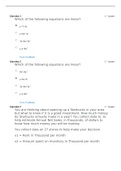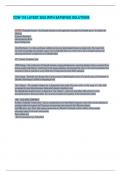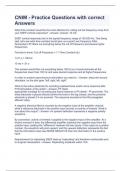Part 2 Digital marketing strategy
Chapter 5 – analyzing the digital business environment
Why is analysis of an organization’s environment important?
In determining their strategy, organizations are almost always guided by information
from the environment. This environment can be defined at the macro-level, by
definition the entire world. Added to this first level of analysis is the performance
environment, also called the meso-level. The third level is the micro-level, this relates
to the immediate (including internal) environment. Due to constant change and
increasing amounts of data, organizations need to make more intensive use of digital
technology.
5.1 The external analysis
The term external analysis refers to the way in which organizations research and
monitor the business environment, also called the macro environment. External
analysis enables organizations to respond proactively to external developments,
which have an impact on the core strategy and functioning of the organization.
External analysis can be seen as a data-driven process, instead of a target-driven
process: it is about analyzing environmental data and not about determining
organizational objectives. As the world is changing so fast, organizations should
continuously monitor the macro environment.
The DESTEP method focuses on demographic, economic, social, technological,
environmental and political trends that (often) cast a far-reaching digital shadow.
5.1.1 External analysis with DESTEP
Through identifying developments in the external environment, organizations can
respond rapidly and effectively to external opportunities and threats. Obviously, this
is a two-way street: organizations can influence the macro environment (for example
the impact of iPad on society).
A handy tool to monitor the external environment is the DESTEP analysis, where
relevant external developments are identified, based on demographic, economic,
social, technological, environmental and political factors. The following systems are
all looking out for the DESTEP factors within the digital channel. The main methods
do so are:
- MasterScan: designed to gather information from digital resources which have
been defined by the organization itself. The downside of this method, is that
new developments are not spotted quickly.
- CI Spider: a search system based on intelligent agent technology. It mitigates
the shortcomings of google.com and creates its own structure. A downside is
that continuous automatic processing and storage of information is not
possible.
- IFS (Information Foraging System): an IFS works using an autonomous
human search method based on heuristic models. The system makes use of
, existing information so that it can recognize relevant information. This system
is the most reliable and comprehensive.
The different factors in the DESTEP analysis are explained below.
Demographic factors
Traditionally speaking, demographics relate to the general population. Consider the
size, age structure, education level and income of the population. Demographic
changes may of course have an impact on the organization.
More and more of the elderly now use the internet.
Economic factors
Economic factors concern all economic developments that directly or indirectly affect
a business. This can, among other things, be about; the economy of a region or
country, consumer confidence, globalization, internationalization or markets,
exchange rates, employment, spending, income, purchasing power, new digital
payment methods and new digital sectors or market forms.
internationalization of markets.
Socio-cultural factors
Socio-cultural factors relate to culture, customs and values. Concepts such as
individualism, religion, marriage, work ethic, sensationalism, career women, attention
for health and the environment, social media usage, mobile usage and digital
shopping behaviour belong here.
shopping on the go on the smart phone.
Technological factors
Technological factors are developments that affect the way organizations use
equipment, technology and materials.
matching digital customer data with customer data from the physical store
location.
Ecological factors
Ecological factors are developments in the physical environment that can affect the
business operations of an organization. Besides the direct impact, ecological
developments have a more indirect impact on business operations. Climate change
might lead to stricter government control. Moreover, environmental factors affect the
way we think about business operations. Currently, sustainability is a hot topic when
it comes to choosing for an organization.
McDonald’s trying to save water to become more sustainable.
Political-legal factors
Political and legal factors are developments within laws and regulations that can
affect business operations. International political decisions – such as boycotts and
trade embargoes – also have an impact on businesses.
It should now be clear that there are many external factors than can affect the
organization’s strategy or products and services. Another important conclusion that
can be drawn is that nothing is static: all factors change continuously.










